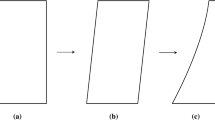Abstract
In this paper, an attempt has been made to highlight the influence of different parameters such as number of cycles, confining pressure, void ratio, gradation, initial anisotropy and stress path on the dynamic properties of granular materials using Discrete Element Method (DEM). A series of strain controlled cyclic triaxial numerical simulations using three dimensional DEM have been carried out on an assembly of spheres. Dynamic properties such shear modulus (G) and damping ratio (D) were determined from the typical hysteresis loop obtained during cyclic triaxial test simulation. It has been observed from the test results that the numerical simulation using DEM has captured the variation of dynamic properties over a wide range of shear strain values for different parameters considered for the current investigation. Maximum shear modulus (G max) was found to be influenced by initial confining pressure, void ratio, gradation and initial anisotropy. Whereas, the damping ratio (D) was found to be influenced by number of cycles, initial confining pressure, gradation and stress path. Further it has been shown that the variation of shear modulus with shear strain can be divided into three distinct zones such as Isotropic Zone (IZ), Anisotropic Zone (AZ) and Stable Anisotropic Zone (SAZ). A drastic reduction of shear modulus with shear strain has been observed in the Anisotropic Zone (AZ). In addition, the results obtained using numerical simulations have been compared with the laboratory experimental values.





















Similar content being viewed by others
References
Chantawarungal K (1993), Numerical simulations of three dimensional granular assemblies. Ph.D. thesis, University of Waterloo, Waterloo
Chien LK, Oh YN (2002) Influence of fines content and initial shear stress on dynamic properties of hydraulic reclaimed soil. Can Geotech J 39:242–253
Chung RM, Yokel FY, Drnevich VP (1984) Evaluation of dynamic properties of sand by resonant column testing. Geotech Test J 7(2):60–69
Cundall PA, Strack ODL (1979) A discrete numerical model for granular assemblies. Geotechnique 29(1):47–65
Das BM, Ramana GV (2010) Principles of soil dynamics. Cengage Learning, USA, pp 128–129
Dinesh SV (2003) Discrete element simulation of static and cyclic behaviour of granular media. Ph.D. thesis, submitted to Indian Institute of Science, Bangalore
Dubujet P, Dedecker F (1998) Micro-mechanical analysis and modelling of granular materials loaded at constant volume. Granular Matter 1:129–136
Hardin BO, Drnevich VP (1972) Shear modulus and damping in soils: Measurement and parameter effects. J Soil Mech Found Div ASCE 96(2):453–469
Ishihara K (1996) Soil behaviour in earthquake geotechnics. Oxford Engineering Science series 46, UK
Iwasaki T, Tatsuoka F (1977) Effects of grain size and grading on dynamic shear moduli of sands. Soils Found 17(3):19–35
Iwasaki T, Tatsuoka F, Tokida K, Yasuda S (1978) A practical method for assessing soil liquefaction potential based on case studies at variuos sites in Japan. Proceedings of the 2nd international conference on microzonation for safer construction research and application vol 2, pp 885–896
Kokusho K (1980) Cyclic triaxial test of dynamic soil properties for wide strain range. Soils Found 20(2):45–60
Kukusho T, Esashi Y (1981) Cyclic triaxial test on sands and coarse materials. Proceedings of the 10th international conference on soil mechanics and foundation engineering, Stockholm, vol 1, pp 673–676
Nagaraja Rao PV (1998) Discrete element simulation of liquefaction behavior of sands. Master of Science (Engg) thesis, Indian Institute of Science, Bangalore
Ng TT, Dobry R (1991) Numerical undrained cyclic simulations using the discrete element method. Proceedings, ASCE engineering mechanics specialty conference, Columbus, vol 2, pp 1234–1238
Ng TT, Dobry N (1994) Numerical simulations of monotonic and cyclic loading of granular soil. Int J Numer Anal Methods Geomech 120(2):388–403
Nimbakar MS (1996) Constitutive behavior of coarse grained granular media—a discrete element approach. Master of Science (Engg) thesis, Indian Institute of Science, Bangalore
Rothenburg L, Bathurst RJ (1989) Analytical study of induced anisotropy in idealized granular materials. Geotechnique 39(4):601–614
Seed HB, Idriss IM (1970) Soil moduli and damping factors for dynamic response analysis. Report EERC 70-10, Earthquake Engineering Research Center, University of California, Berkeley
Silver ML, Seed HB (1971) Volume changes in sands during cyclic loading. J Soil Mech Found Div ASCE 97(9), Proc. paper no. 1171
Sitharam TG (2003) Discrete element modeling of cyclic behaviour of granular materials. Geotech Geol Eng 21:297–329
Sitharam TG, Vinod JS (2009) Critical state behaviour of granular materials from isotropic compression and rebound paths: DEM simulations. Granular Matter 11(1):33–42
Sitharam TG, Dinesh SV, Shimizu N (2002) Micromechanical modeling of monotonic shear behaviour of granular media using three dimensional DEM. Int J Numer Anal Methods Geomech 26:1167–1189
Sitharam TG, Vinod JS, Rothenburg L (2005) Shear behavior of glass beads, International conference micromechanics of granular media. Powder and Grains, University of Stuttgart, Germany, pp 257–260
Tatsuoka F, Iwasaki T, Takagi Y (1978) Hystertic damping of sands under cyclic loading and its relation to shear modulus. Soils Found 18(2):25–40
Tatsuoka F, Iwasaki T, Yoshida S, Fukushima S, Sudo H (1979) Shear modulus and damping tests on clean sand secimens reconstutied by various methods. Soils Found 19(1):39–54
Author information
Authors and Affiliations
Corresponding author
Rights and permissions
About this article
Cite this article
Sitharam, T.G., Vinod, J.S. Evaluation of Shear Modulus and Damping Ratio of Granular Materials Using Discrete Element Approach. Geotech Geol Eng 28, 591–601 (2010). https://doi.org/10.1007/s10706-010-9317-5
Received:
Accepted:
Published:
Issue Date:
DOI: https://doi.org/10.1007/s10706-010-9317-5




